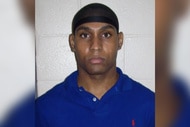Create a free profile to get unlimited access to exclusive videos, breaking news, sweepstakes, and more!
How Did The Real-Life Women Who Inspired The ‘Hustlers’ Movie Finally Get Caught?
“It sounds so bad to say that we were, like, drugging people. But it was, like, normal," one of the scheme's ringleaders, Roslyn Keo, once said.

It sounds like something straight out of a movie: Two women — one a stripper, the other a veteran still working in the club scene — grow tired of witnessing their rich Wall Street clients blow through cash while they struggle to maintain their own lifestyles, so they decide to turn the tables on the men by drugging them and stealing hundreds of thousands of dollars.
Well, the above scenario is indeed the general plot of an upcoming film starring such big names as Jennifer Lopez, Constance Wu, and Cardi B, but the story is far from fictional. “Hustlers,” which hits theaters on Sept. 13, is based off a New York Magazine article, “The Hustlers at Scores," written by Jessica Pressler.
As outlined in Pressler’s story, Roslyn Keo, a stripper, and Samantha Barbash, a “veteran,” teamed up to scheme wealthy men out of thousands by first partying with them — or by getting girls that they’d hired to lure the men to a strip club using the promise of a good time — and then drugging them so that they could use their credit cards.
Keo inspired the character Destiny in the “Hustlers” film, portrayed by Constance Wu, while Jennifer Lopez co-stars in the film as Ramona, the second ringleader character, based off Barbash.
As Pressler pointed out in her 2015 article, it’s a vaguely Robin Hood-esque story, if, instead of giving the money to the poor, Robin Hood had expensive tastes and spent everything he stole on expensive cars and designer fashion. It apparently went off without a hitch for quite some time, but the women did eventually end up in legal trouble. So, how did the crazy scheme all finally come crashing down?
How did the "Hustlers" scheme work?
After the 2008 financial crisis, the Wall Street regulars who were known to blow loads of cash in one night at strip clubs stopped spending as much, and many of them stopped coming in at all. But Keo and Barbash weren’t content to take an unofficial pay cut.
As part of Keo and Barbash's ploy, Keo, or another girl in the industry who’d been recruited, would go out looking for wealthy men at bars and hot spots around the city and eventually convince them to come out to a strip club with them for a night out, according to an ABC News report. They would then get a portion of the night’s earnings from club owners.
Things got more illicit from there, however, as Keo and Barbash began hiring sex workers to be intimate with their marks because that's what the men wanted and expected, ABC News reports. Then came the credit card portion of the scam: Before using the men’s cards to make thousands of dollars of fraudulent purchases, the women would first drug the man using a mix of MDMA and ketamine.
As Keo explained to New York Magazine four years ago, it was “just a sprinkle,” but it was enough to get the job done. The marks would be so out of it that they would happily give up important information like their social security numbers and mother’s maiden name when Keo or another one of the women would ask in order to verify purchases with the credit card company.
The crimes that the women committed were faded from the men’s memory the following morning, as the ketamine would make it so that their marks barely remembered the night before, if they were able to recall anything at all, according to ABC.
“It sounds so bad to say that we were, like, drugging people,” Keo told Pressler in 2015. “But it was, like, normal.”
And if the men did call the clubs, upset about the charges? Keo recalled to Pressler that Barbash would talk sweetly to them over the phone until they dropped the issue, reportedly telling them, “You were so happy, don’t you remember? You were tipping everyone.”
How did they get caught?
So, how did it all come crashing down? Keo and Barbash’s plot depended heavily on their victims being too embarrassed to report any suspected crimes; both women believed that the men would instead accept the loss in order to return to their ordinary lives — oftentimes lives that involved wives and children — rather than risk taking a hit to their reputation.
However, what they didn’t count on was Dr. Zyad Younan, a cardiologist from New Jersey who refused to accept their fraudulent charges without putting up a fight and who, eventually, would share his story with the authorities.
“Someone had to stand up, you know, and stop it,” Younan told "20/20" of his decision to come forward, according to ABC News.
Younan first grew suspicious after being notified by his credit card company that he’d been charged $135,000 at Scores strip club, despite not being able to remember spending so much money or even being at that club, the outlet reports. He refused to pay and the club tried to sue him for the full amount, but he was soon contacted by the NYPD and DEA. They had already been investigating the women for months at that point and needed Younan to cooperate as a key witness, which he happily did, according to ABC.
The women’s scheme was also dismantled thanks to an insider who turned on the core group and became an anonymous informant whose identity has still not been released. That woman was recorded admitting to the scheme during a phone call with a man who had pleaded with her to tell him what happened to him the night that his money had gone missing, according to Pressler’s article.
The soon-to-be informant admitted that they’d drugged him, and the man recorded the conversation and played it for the authorities; police then recruited the girl as an informant, according to New York Magazine. Although the anonymous woman helped authorities with a sting operation that was ultimately unsuccessful in leading to any arrests (on that occasion, none of the women ran any of the men’s credit cards), her cooperation and the information she relayed to police played a huge role in helping authorities collect enough evidence to eventually arrest Keo, Barbash, and other women involved in the scheme.
Did anyone go to jail?
Miraculously, the so-called hustlers involved in the scheme managed to mostly avoid any serious time behind bars.
Keo, facing charges of grand larceny and attempted assault, accepted a plea deal that kept her out of jail and instead left her with five years of probation, the New York Post reports. Following her sentencing, her lawyer Samuel Gregory reportedly told the outlet, “She’s ready to start rebuilding her life for her and her daughter.”
Barbash, who is reportedly so displeased with the “Hustlers” film that she’s planning to sue both Lopez and the studio behind it, also managed to avoid jail time in exchange for five years of probation after pleading guilty to conspiracy, assault, and grand larceny, according to another report from the Post.
Marsi Rosen and Karina Pascucci, two women who were a part of the core group participating in the scheme, were not as lucky as Keo and Barbash and were required to spend some time in jail, the outlet reports. Both were ordered to spend their weekends in jail for four months, which would then be followed by a five-year probation sentence, according to the Post.


























